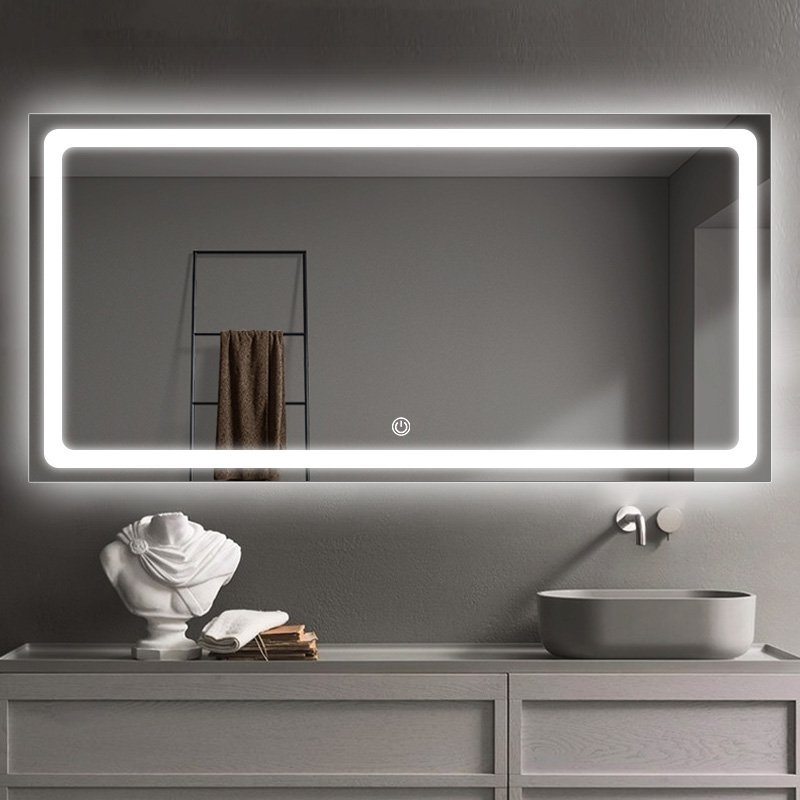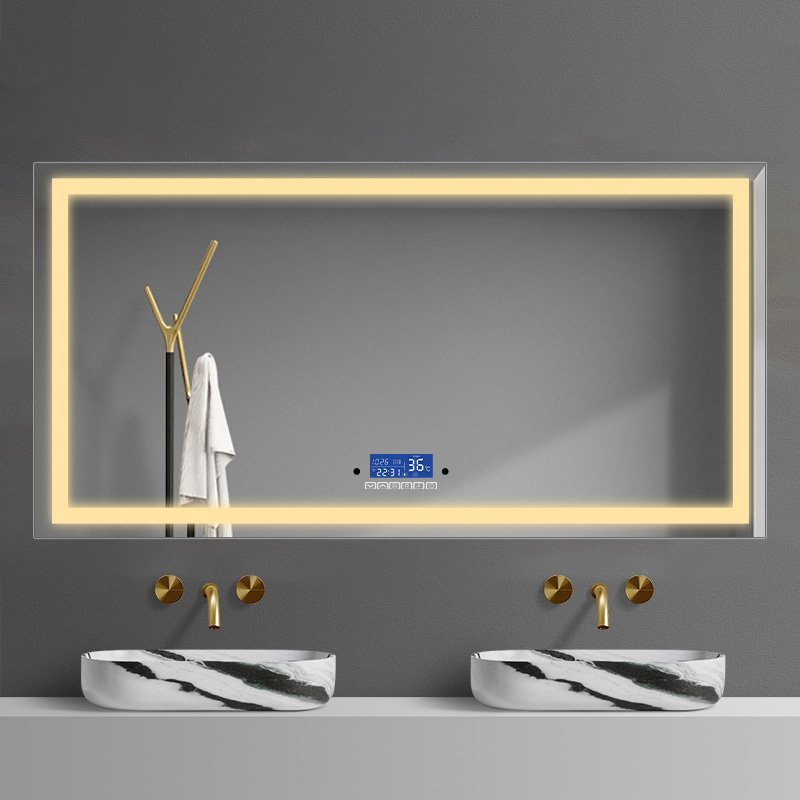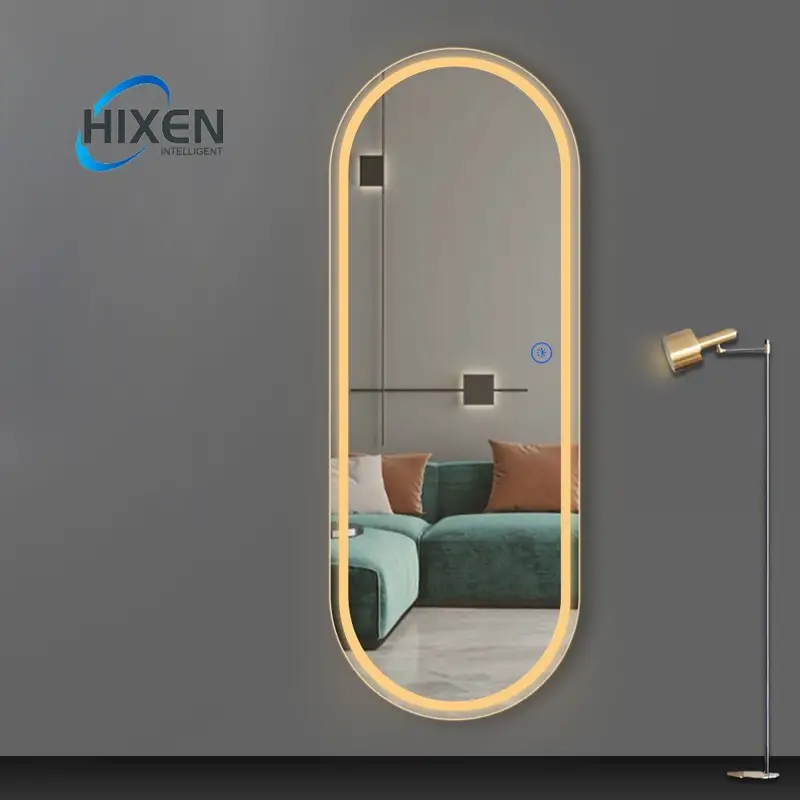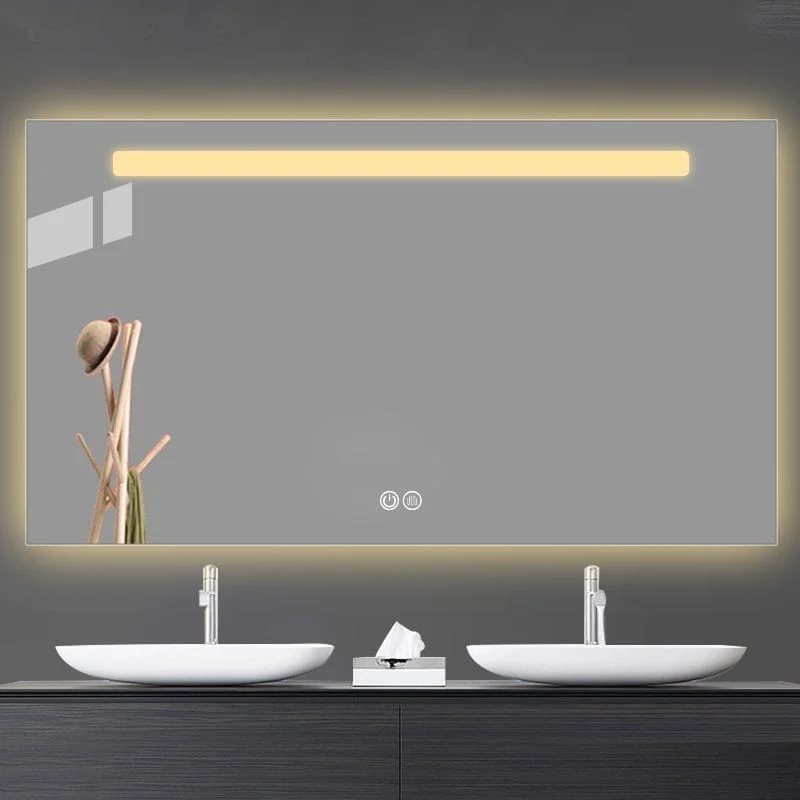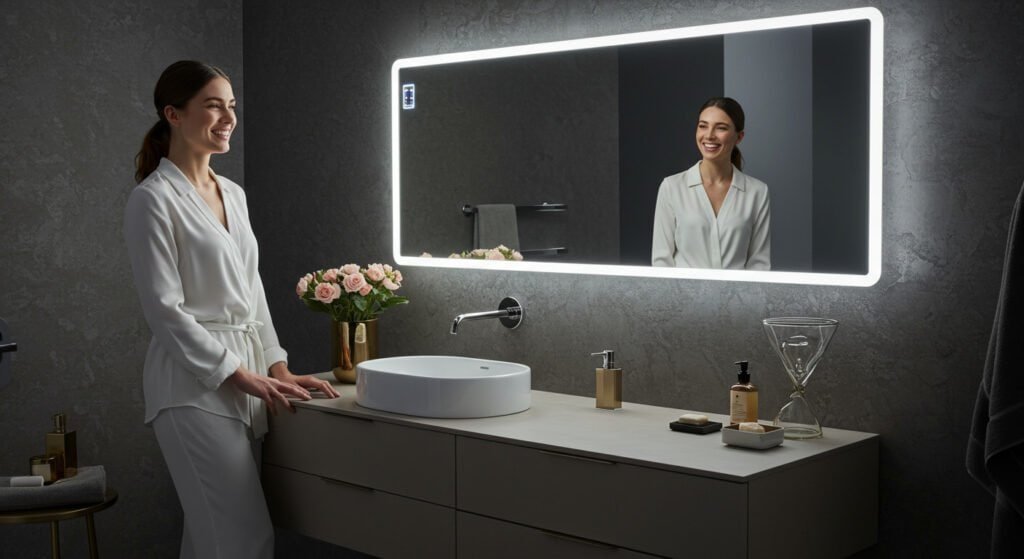|
あなたを取得します トリニティオーディオ プレイヤーレディ...
|
ライト付きミラー have become a must-have in today’s modern bathrooms. What are they made of? Knowing the materials used in illuminated mirrors is important for both how they work and how they look.
Lighted mirrors are primarily made from glass and plastic, incorporating integrated LED lights. These materials provide durability and practicality, ensuring the mirrors fulfill both aesthetic and functional purposes.
If you want to know more about how they’re built and what they’re made of, keep reading!

What Material Are Mirrors Made Of?
Mirrors are typically made out of glass or plastic. Glass mirrors give you a clear, high-quality reflection. Plastic mirrors are lightweight and less fragile. Depending on what you’re using them for, either type can be effective.
Most mirrors are made out of glass. Glass mirrors give you a clear, high-quality reflection. Plastic mirrors are less reflective but are often used in lightweight applications.
Glass is the preferred material for high-end and lighted mirrors because of its clarity and durability. しかし, in certain situations where safety is a concern (such as in a child’s room), plastic might be a better option.
- Glass
- 説明: The most traditional and widely used material for mirrors. Glass mirrors are usually coated with a thin layer of reflective material, such as silver or aluminum, on the back.
- 利点: Glass mirrors are perfect for home and commercial use because they offer high optical clarity, durability, and a polished look.
- Acrylic
- 説明: A type of plastic called polymethyl methacrylate (PMMA). Acrylic mirrors are lighter and more shatter-resistant than glass.
- 利点: They are often used in places where safety is a concern, such as in children’s rooms or public places.
- Polycarbonate
- 説明: Another type of plastic that is even more impact-resistant than acrylic. Polycarbonate mirrors are strong and durable.
- 利点: Polycarbonate mirrors are suitable for high-risk environments because they can take a lot of abuse without breaking.
- Metal
- 説明: Some are made from polished metals like stainless steel or aluminum. These are often used in specialized applications.
- 利点: Metal mirrors are highly reflective and won’t shatter, making them great for industrial and outdoor applications.
- Ceramic and Other Materials
- 説明: It’s less common, but you can also find mirrors made of ceramic or other composite materials designed for specific applications.
- 利点: These materials can provide unique aesthetic qualities and are often used in artistic or decorative mirrors.
The material you choose for your mirror will affect its durability, weight, 反射率, and application. Glass is the most popular choice for traditional mirrors. Acrylic and polycarbonate are popular for safety and lightweight needs.
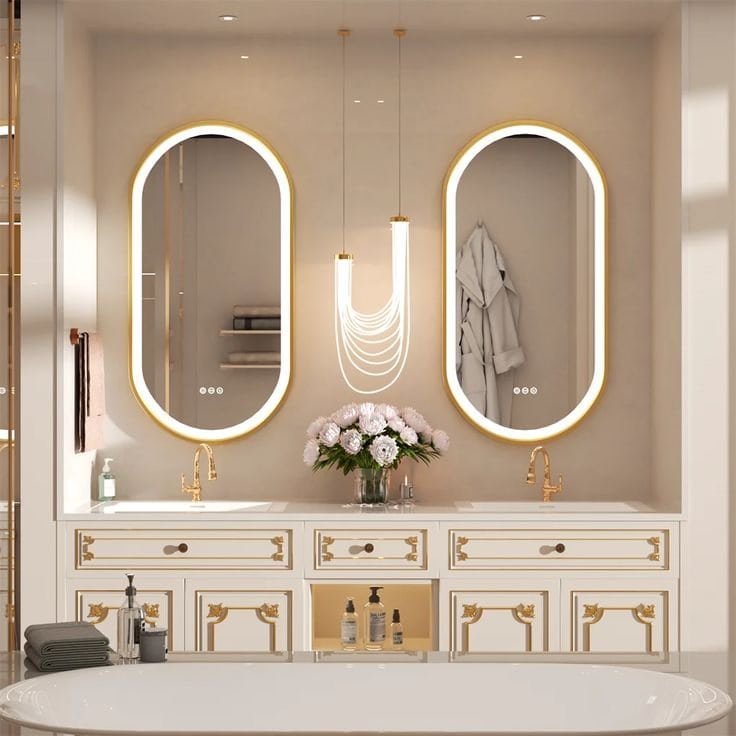
What Are the Steps in the Production of a Lighted Mirror?
Producing a lighted mirror involves several key steps: デザイン, material selection, assembly, and quality control. Each step is important to make sure the final product meets quality standards.
The production process includes designing, selecting materials, assembling components, and performing quality checks. This meticulous process ensures that the mirror is both functional and attractive.
Steps in the Production of a Lighted Mirror
- Design Phase
- The process starts with the design of the lighted mirror. Designers create specifications based on functionality, 美学, and customer requirements. This includes deciding on the size, 形, and location of the LED lights.
- 材料の選択
- Once the design is complete, manufacturers choose materials. Common materials include high-quality glass or acrylic for the mirror surface, and durable plastics or metals for the frame. LED lights and electrical components are also selected.
- Glass Cutting and Shaping
- If glass is used, it is cut and shaped to the specifications of the design. This step requires precision to make sure the edges are smooth and the dimensions are correct.
- Surface Treatment
- The glass or acrylic surface may be treated to increase durability and reflectivity. This can include coatings that prevent fogging or improve light diffusion.
- LED Integration
- The next step is to integrate the LED lights. This is usually done by creating a groove or housing in the frame where the lights will be located. The LEDs are then securely fastened.
- Electrical Wiring
- The electrical components, such as wiring and switches, are installed. This includes making sure the power source is compatible and safely integrated into the design of the mirror.
- Assembly
- Once all the components are ready, the mirror is assembled. This includes attaching the mirror to the frame, securing the LED lights, and making sure all electrical connections are safe and working.
- Quality Control
- After assembly, the mirror goes through a series of quality control checks. This includes looking for defects, testing the lighting and electrical components, and making sure the overall quality meets industry standards.
- Packaging
- Once the mirror passes quality control, it is carefully packaged for shipping. Packaging is designed to protect the mirror during shipping and prevent damage.
- Distribution
- ついに, the packaged mirrors are shipped to retailers or directly to customers, often with detailed instructions for installation and care.
During assembly, LED lights are integrated into the mirror’s design, often using adhesive or fixtures. After assembly, rigorous quality checks ensure that the mirror functions correctly and is free of defects.
What are lightweight mirrors made of?
Lightweight mirrors are often made from materials that are both durable and less dense than traditional glass. Here are the common materials:
Common Materials for Lightweight Mirrors
- Acrylic
- Acrylic mirrors are made from a type of plastic called polymethyl methacrylate (PMMA). They are lightweight, shatter-resistant, and have good optical clarity, making them ideal for a variety of applications, including homes and commercial spaces.
- Polycarbonate
- Polycarbonate mirrors are another type of plastic that is even more impact-resistant than acrylic. They are also lightweight and can withstand harsh conditions, making them suitable for high-risk environments.
- Glass (with Thin Coating)
- Some lightweight mirrors use thin sheets of glass that have been specially treated or coated to reduce weight. These mirrors maintain good reflective quality while being lighter than standard glass mirrors.
- Foam Core
- Some mirrors use a foam core sandwiched between reflective surfaces. This design greatly reduces weight while still providing a usable reflective surface.
Advantages of Lightweight Mirrors
- 携帯性: Easy to transport and install, making them ideal for a variety of settings, including temporary installations.
- Safety: Lightweight materials, especially plastics, reduce the risk of injury from breakage.
- Versatility: Lightweight mirrors can be used in a variety of applications, from home decor to outdoor settings.
Lightweight mirrors are especially popular in situations where safety and ease of handling are important, such as in children’s rooms, travel mirrors, or in commercial displays.

Do Lighted Mirrors Need Electricity?
はい, most lighted mirrors need electricity to power their built-in LED lights. Knowing their power requirements is important for installation and use.
Most lighted mirrors do require electricity to operate their LED lights. Some models can also run on battery power, making them versatile for different settings.
When selecting a lighted mirror, think about how you will power it. Many mirrors plug into standard outlets, while others may offer USB or battery options for added convenience.
How Are Lighted Mirrors Powered?
You can power lighted mirrors in a few different ways. You can plug them into a traditional electrical outlet, use a USB connection, or run them off batteries. This flexibility allows you to install them in a variety of situations.
You can power lighted mirrors in a few different ways. You can plug them into a traditional electrical outlet, use a USB connection, or run them off batteries. This flexibility allows you to install them in a variety of situations.
For a more permanent installation, you can hardwire them. しかし, if you need a portable option, you can run them off batteries.
Are Mirrors Plastic or Glass?
Mirrors can be made from both plastic and glass. It depends on what you’re using them for.
Mirrors can be either plastic or glass. Glass mirrors are what you think of when you think of a mirror. They’re clear. They’re nice. They’re glass. Plastic mirrors are lightweight and more durable in certain environments.
Most mirrors are made of glass. しかし, plastic mirrors are popular in situations where safety and weight are a concern.
What Makes Mirrors So Expensive?
The price of mirrors can vary widely. High-end mirrors can cost a lot more than standard mirrors. Several things can make mirrors expensive, especially when it comes to specialty mirrors like カスタムLEDミラー.
1. Material Quality:The biggest factor in the cost of mirrors is the quality of the materials. Mirrors made from premium glass are going to be clearer and last longer than mirrors made from cheaper materials like plastic. また, the coating on the back, which is often made of silver or aluminum, can make a big difference.
Manufacturers who use top-grade materials, like the ones you’ll find in luxury bathroom mirror manufacturers, are going to charge more because their products are going to perform better and look better over the long run.
2. Customization and Personalization: Personalized LED mirrors are going to cost more because they have unique features designed to your exact specifications. Maybe you want a specific size, 形, or functionality like adjustable lighting or built-in technology.
LED mirror manufacturers are going to charge more because they’re using advanced technology to create a mirror to your exact specifications. Whether it’s the size, 形, or design you want, they’re going to make it for you, and that’s going to cost you.
3. Craftsmanship and Design: The artistry that goes into making mirrors can also make them more expensive. High-end mirrors might have intricate designs, beveled edges, or decorative frames created by skilled artisans.
It takes time and skill to create that level of craftsmanship, and you’re going to pay for it. Bathroom mirror manufacturers who focus on unique and stylish designs are going to charge more because they’re serving a market that values style and innovation.
4. Technology Integration: モダンな鏡, especially personalized LED mirrors, often come with advanced technologies. They might have Bluetooth connectivity, アンチフォグ機能, and built-in speakers.
These features aren’t just cool; they require a lot of engineering and design. When you start integrating technology into a mirror, you have to spend a lot of money on research and development. All of that cost gets passed on to you in the form of a higher price.
5. Brand Reputation: ついに, the brand of the mirror can make a big difference in the price you pay. If it’s a well-known brand that has a reputation for quality and reliability, you’re going to pay more.
Consumers are willing to pay more for mirrors from reputable LEDミラーメーカー because they know they’re going to get a great product, excellent customer service, and good warranty options.
The price of mirrors comes down to the quality of the materials, the options for customization, the craftsmanship, the technological features, and the reputation of the brand. Understanding these factors can help you make a better decision when you’re buying a mirror.
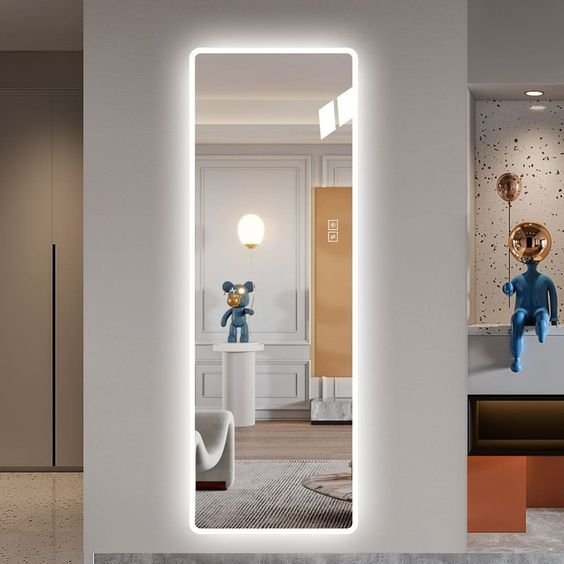
What Are LED Mirrors Made Of?
LED mirrors are made from glass or plastic with LED lights around the edges. The material you choose can impact how well the mirror works and how it looks.
LED mirror manufacturers will often make custom options, so you can pick the exact materials and size you want.
LEDミラーの欠点は何ですか?
There are some downsides to LED mirrors or LED bathroom mirror, and it’s important to know what they are.
LED mirrors can have disadvantages, such as potential glare and the need for electricity. さらに, the initial cost may be higher than traditional mirrors.
But you need to weigh these against the advantages, like energy efficiency and how long they last.
How Long Do Lighted Mirrors Last?
The lifespan of lighted mirrors can vary based on the materials used and how they are maintained. Generally, they can last many years with proper care.
How long do lighted mirrors last? They last several years, depending on the quality of the materials and how well you take care of them. If you clean them regularly and don’t abuse them, they will last a long time.
If you buy high-quality mirrors, they will last longer and give you more value over time.
Are Lighted Mirrors Safe?
When used properly, lighted mirrors are safe. But you must follow the safety instructions for installation and use.
Lighted mirrors are safe, but you need to follow electrical safety precautions. また, make sure they are installed correctly to avoid any problems.
Check for certifications and follow the manufacturer’s instructions.
When Did They Stop Using Mercury in Mirrors?
The use of mercury in mirrors was phased out in the 20th century because of health and environmental concerns. This change led to the development of safer materials.
Mercury was largely phased out of mirror production by the early 20th century. The transition to safer alternatives has significantly improved the environmental impact of mirror manufacturing.
This change has also led to more sustainable practices in the industry.
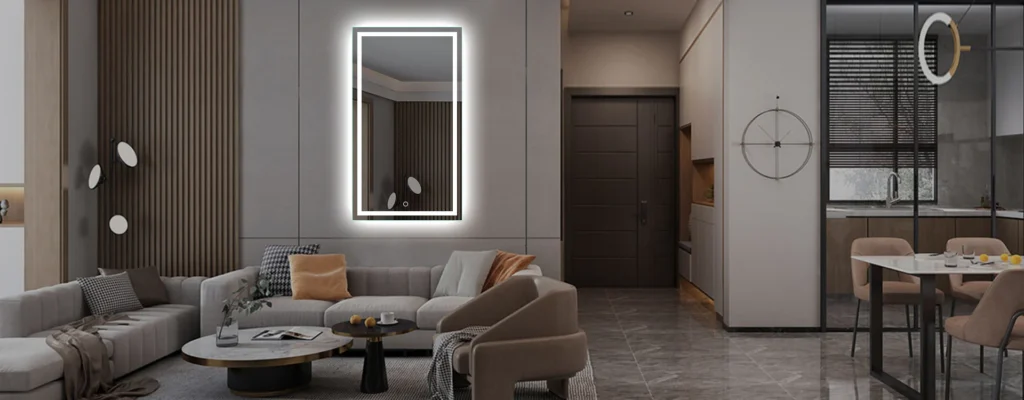
What Are Unbreakable Mirrors Made Of?
Unbreakable mirrors are typically made from materials like polycarbonate or acrylic.
Unbreakable mirrors are typically made from polycarbonate or acrylic. These materials are designed not to shatter, so they are perfect for high-risk environments.
These mirrors are popular in homes with children or in public spaces where safety is a concern.
Lighted mirrors are mostly made of glass and plastic. They’re a combination of aesthetics and functionality. Knowing what they’re made of can help you make a better buying decision. If you want more information, お問い合わせ!





